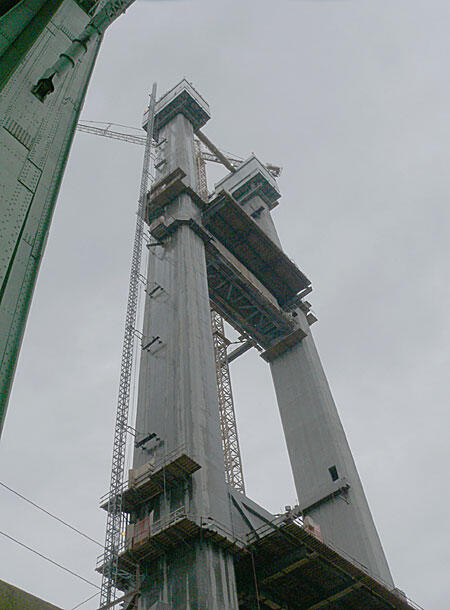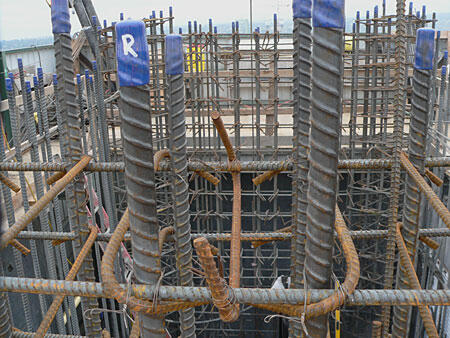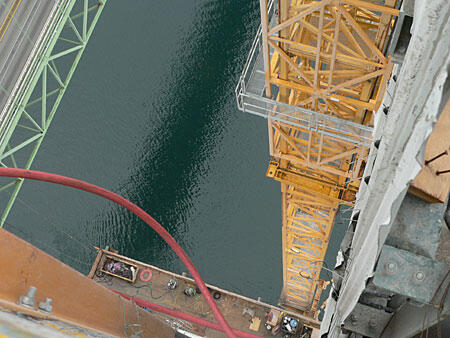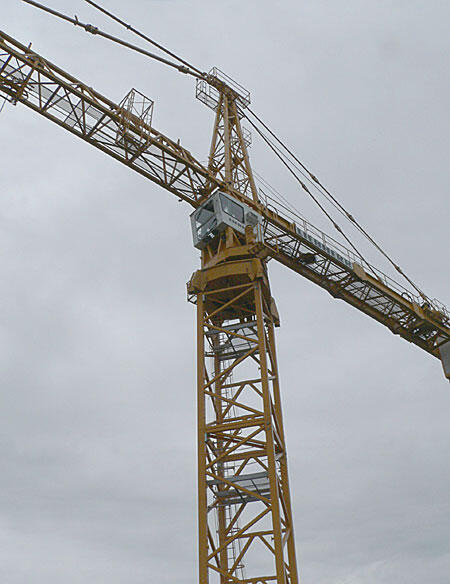
When viewed from below, the new bridge towers are magnificent and soaring. Unlike a tall building, there is nothing surrounding the towers to detract from their majestic height; one’s insignificance in the face of an engineering miracle is readily apparent. Seen at the top are two square enclosures, connected by a narrow walkway. These are called birdcages, and this is the destination of the final part of the tour. I suspect that vultures live therein, to feast like mythical harpies on their prey — those foolish enough to ascend to such absurd heights.



Between the two tower birdcages there is a narrow catwalk, with open steel grate flooring and a fairly skimpy railing. Mike — our tour guide — informs us that we are going to cross over to the other birdcage, and I marvel at his quirky sense of humor — until I realize he is serious. That wet spot on my trousers may be from the sprinklers, but it seems awfully warm…

To say it is intimidating to look down from the lofty perch of this catwalk is an understatement — think: Indiana Jones on the rope bridge in Temple of Doom. But again we make it without a newsworthy calamity, and from this birdcage (southern-most in the west tower) we have an altogether-too-close view of the top of the construction crane.

Construction cranes (also called tower cranes) themselves are a more-than-fascinating work of engineering. Carefully balanced to handle large loads without tipping over, they perform the most amazing feat of gymnastics in engineering: they can grow themselves taller. The rotating gearbox at the top (called a slewing unit) is detached from its supporting section, and is lifted 20 feet by hydraulics, contained in a three-sided mobile cage surrounding the tower sections, which can be seen in the prior picture from the catwalk. The crane then lifts a 20 foot section of tower, and positions it under the slewing unit, between the four hydraulic jacks. The new section is then attached below and to the slewing unit above–and all is well until a new section is required. This process strikes me as akin to performing your own hemorrhoidectomy — it’s a job best left to the experts, so don’t try this on your stepladder at home.
At this point, we take a few more photos, and Mike informs us it’s time to head back down. The fear has long since passed, and the amazing tour is drawing to a close — with far more sadness than relief. It has been the opportunity of a lifetime, and despite my acrophobia — substantially diminished having conquered this demon — I would do it again in a heartbeat.
Mike informs us that in a few weeks, the only way to reach the top of the towers will be by catwalks strung between the shore anchors and the towers — which will be used to facilitate the spinning of the cables for the bridge. Perhaps I’ll skip the next tour after all and keep my fond memories of this one instead.
Back soon with tales of cable catwalks and spinning.